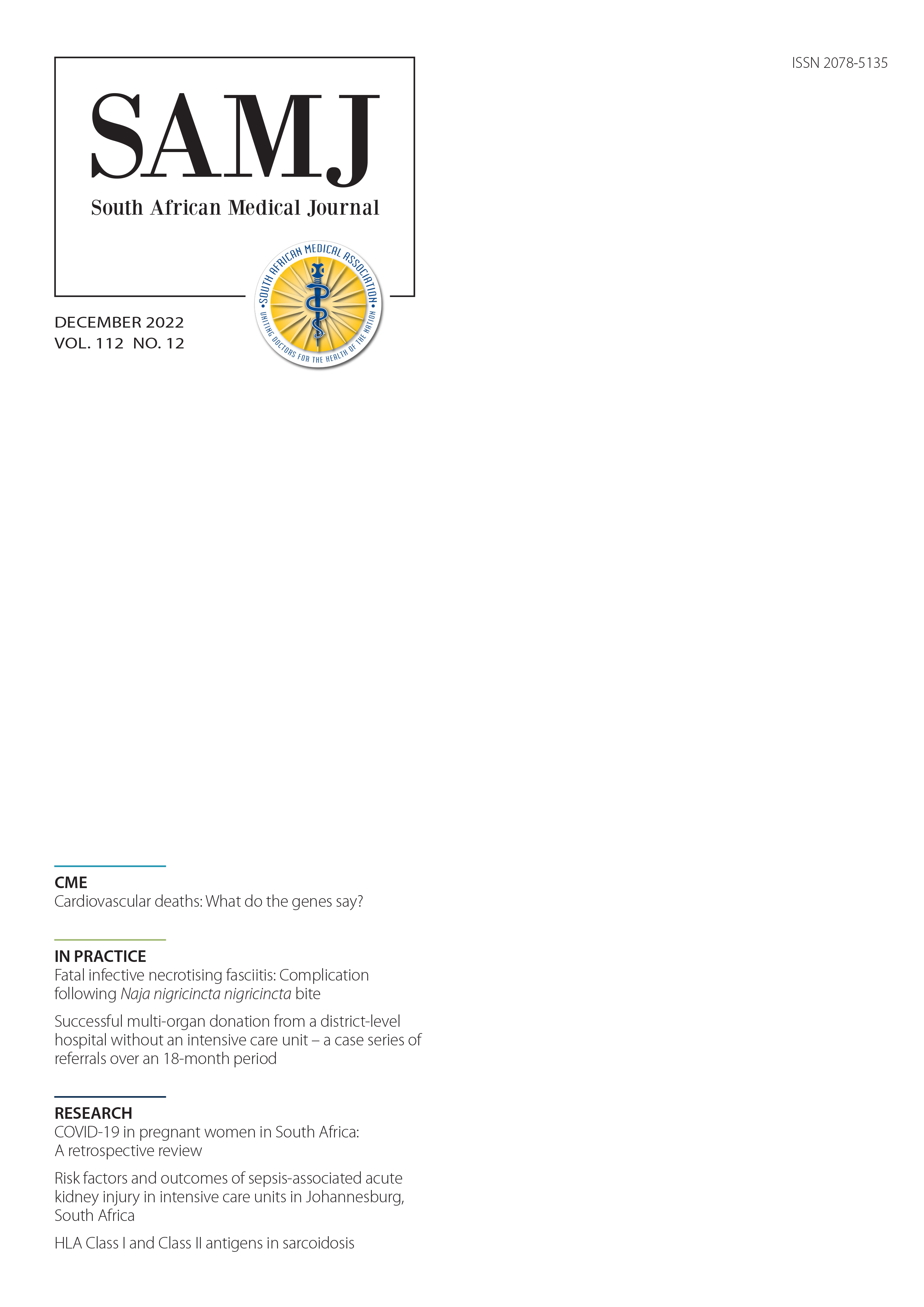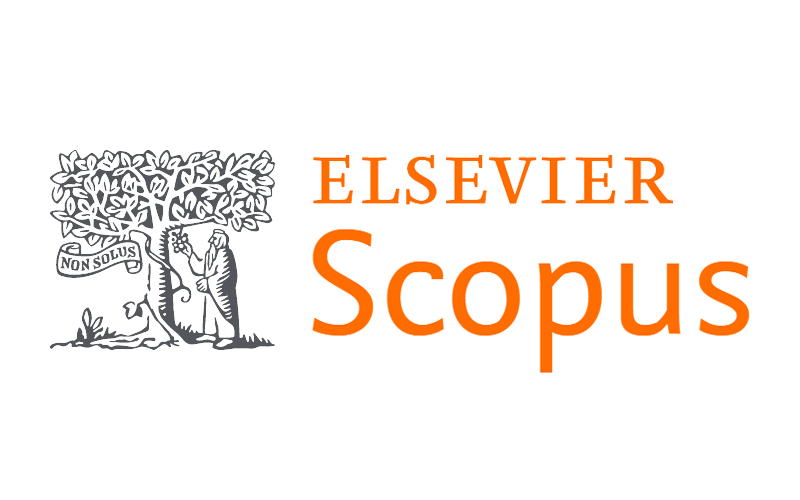COVID‑19 in pregnant women in South Africa: A retrospective review
DOI:
https://doi.org/10.7196/SAMJ.2022.v112i12.16552Keywords:
COVID-19, ObstetricsAbstract
Background. The majority of maternal deaths in South Africa (SA) occur as a result of non-pregnancy-related infections (NPRI). Pregnancy is a known risk factor in severe COVID‑19, increasing the burden of NPRI in SA. In this study, we describe the prevalence, profile and clinical outcomes of pregnant women with COVID‑19 admitted to a tertiary facility.
Objectives. To describe the prevalence, profile and clinical outcomes of pregnant women with COVID‑19 admitted to a tertiary facility in Gauteng, SA.
Methods. We performed a retrospective review of all pregnant women with COVID‑19 admitted to Charlotte Maxeke Johannesburg
Academic Hospital between 6 March and 30 August 2020. Data collected included demographics, medical history, obstetric history, clinical findings and laboratory variables. Outcomes assessed were mortality, admission to intensive care unit (ICU), symptomatic v. asymptomatic disease, maternal and fetal outcome and mode of delivery.
Results. A total of 204 pregnant women were included in the study. Of these, 33 (16.2%) women were critically ill, with 21 (10.3%) admitted to the ICU and 3 (1.5%) deaths related to COVID‑19. The median gestational age was 37 weeks and median birthweight 2 940 g. Sixty-seven women (33%) were HIV-positive, in keeping with national statistics regarding HIV in pregnancy. Caesarean section was the most common mode of delivery (n=105, 60%). However, no women underwent caesarean section for indications related to COVID‑19.
Conclusion. COVID‑19-related mortality in our cohort was higher than that seen internationally, likely due to differences in background maternal mortality rates and difficulty in accessing care.
References
National Committee on the Confidential Enquiries into Maternal Deaths. Saving Mothers 2017-2019: Seventh triennial report on confidential enquiries into maternal deaths in South Africa. Pretoria: National Department of Health, 2020.
Budhram S, Vannevel V, Botha T, et al. Maternal characteristics and pregnancy outcomes of hospitalised pregnant women with SARS-CoV-2 infection in South Africa: An International Network of Obstetric Survey Systems-based cohort study. Int J Gynecol Obstetr 2021;155(3):455-465. https:// doi.org/10.1002/ijgo.13917
Soma-Pillay P, Moodley J, Pattinson R, et al. The effect of the first wave of Covid-19 on use of maternal and reproductive health services and maternal deaths in South Africa. Obstetrics and Gynaecology Forum. 2020 Dec 1;30(4):38–46. https://doi.org/10.10520/ejc-medog-v30-n4-a10
Basu JK, Jeketera CM, Basu D. Obesity and its outcomes among pregnant South African women. Int J Gynaecol Obstet 2010;110(2):101-104. https://doi.org/10.1016/j.ijgo.2010.02.020
Guan W, Ni Z, Hu Y, et al. Clinical characteristics of coronavirus disease 2019 in China. New Eng J Med 2020;382(18):1708-1720. https://doi.org/10.1056/NEJMoa2002032
Statistics South Africa. South Africa Demographic and Health Survey 2016. Key indicator report. Pretoria: StatsSA, 2017. https://www.statssa.gov.za/publications/Report%2003-00-09/Report%2003- 00-092016.pdf (accessed 16 November 2022).
Venturas J, Zamparini J, Shaddock E, et al. Comparison of outcomes in HIV-positive and HIV-negative patients with COVID-19. J Infection 2021;83(2):217-227. https://doi.org/10.1016/j.jinf.2021.05.020
Jassat W, Cohen C, Tempia S, et al. Risk factors for COVID-19-related in-hospital mortality in a high
HIV and tuberculosis prevalence setting in South Africa: A cohort study. Lancet HIV 2021;8(9):e554-
https://doi.org/10.1016/S2352-3018(21)00151-X
Western Cape Department of Health in collaboration with the National Institute for Communicable
Diseases, South Africa. Risk Factors for Coronavirus Disease 2019 (COVID-19) Death in a Population Cohort Study from the Western Cape Province, South Africa. Clin Infect Dis. 2021 Oct 5;73(7):e2005– 15. https://doi.org/10.1093/cid/ciaa1198
Pastick KA, Nicol MR, Smyth E, et al. A Systematic Review of Treatment and Outcomes of Pregnant Women With COVID-19-A Call for Clinical Trials. Open Forum Infect Dis. 2020 Aug 13;7(9):ofaa350. https://doi.org/10.1093/ofid/ofaa350
Villar J, Ariff S, Gunier RB, et al. Maternal and neonatal morbidity and mortality among pregnant women with and without COVID-19 infection: The INTERCOVID Multinational Cohort Study. JAMA Pediatrics 2021;175(8):817-826. https://doi.org/10.1001/jamapediatrics.2021.1050
Zambrano LD, Ellington S, Strid P, et al. Update: Characteristics of symptomatic women of reproductive age with laboratory-confirmed SARS-CoV-2 infection by pregnancy status – United States, January 22 - October 3, 2020. Morb Mortal Weekly Rep 2020;69(44):1641-1647. https://doi. org/10.15585/mmwr.mm6944e3
Allotey J, Stallings E, Bonet M, et al. Clinical manifestations, risk factors, and maternal and perinatal outcomes of coronavirus disease 2019 in pregnancy: Living systematic review and meta-analysis. BMJ 2020;370:m3320. https://doi.org/10.1136/bmj.m3320
Badr DA, Mattern J, Carlin A, et al. Are clinical outcomes worse for pregnant women at ≥20 weeks’ gestation infected with coronavirus disease 2019? A multicenter case-control study with propensity score matching. Am J Obstet Gynecol 2020;223(5):764-768. https://doi.org/10.1016/j.ajog.2020.07.045
Kyle MH, Glassman ME, Khan A, et al. A review of newborn outcomes during the COVID-19 pandemic. Semin Perinatol 2020;44(7):151286. https://doi.org/10.1016/j.semperi.2020.151286
Dashraath P, Wong JLJ, Lim MXK, et al. Coronavirus disease 2019 (COVID-19) pandemic and pregnancy. Am J Obstet Gynecol 2020;222(6):521-531. https://doi.org/10.1016/j.ajog.2020.03.021
Gale C, Quigley MA, Placzek A, et al. Characteristics and outcomes of neonatal SARS-CoV-2 infection
in the UK: A prospective national cohort study using active surveillance. Lancet Child Adolesc Health
;5(2):113-121. https://doi.org/10.1016/S2352-4642(20)30342-4.
Jering KS, Claggett BL, Cunningham JW, et al. Clinical characteristics and outcomes of hospitalized
women giving birth with and without COVID-19. JAMA Intern Med 2021;181(5):714-717. https://doi.
org/10.1001/jamainternmed.2020.9241
Knight M, Bunch K, Vousden N, et al. Characteristics and outcomes of pregnant women admitted to hospital with confirmed SARS-CoV-2 infection in UK: national population based cohort study BMJ 2020;369:m2107. https://doi.org/10.1136/bmj.m2107
HarrisPA,TaylorR,MinorBL,etal.TheREDCapconsortium:Buildinganinternationalcommunityof software platform partners. J Biomed Inform. 2019;95:103208. https://doi.org/10.1016/j.jbi.2019.103208 21. Harris PA, Taylor R, Thielke R, et al. Research electronic data capture (REDCap) – a metadata-driven
methodology and workflow process for providing translational research informatics support. J Biomed
Inform 2009;42(2):377-381. https://doi.org/10.1016/j.jbi.2008.08.010
Donders F, Lonnée-Hoffmann R, Tsiakalos A, et al. ISIDOG recommendations concerning COVID-19
and pregnancy. Diagnostics 2020;10(4):243. https://doi.org/10.3390/diagnostics10040243
National Department of Health, South Africa. 2019 ART clinical guidelines for the management of HIV in adults, pregnancy, adolescents, children, infants and neonates. Pretoria: NDoH, 2020. https:// www.knowledgehub.org.za/elibrary/2019-art-clinical-guidelines-management-hiv-adults-pregnancy-
adolescents-children-infants (accessed 16 November 2022).
Vousden N, Bunch K, Morris E, et al. The incidence, characteristics and outcomes of pregnant women
hospitalized with symptomatic and asymptomatic SARS-CoV-2 infection in the UK from March to September 2020: A national cohort study using the UK Obstetric Surveillance System (UKOSS). PLoS One 2021;16(5):e0251123. https://doi.org/10.1371/journal.pone.0251123.
UK Government. Coronavirus (COVID-19) in the UK. London: gov.uk, 2022. https://coronavirus. data.gov.uk/details/cases (accessed 8 February 2022).
National Institute for Communicable Diseases. Weekly epidemiological brief. NICD, 2021.
https://www.nicd.ac.za/diseases-a-z-index/disease-index-covid-19/surveillance-reports/weekly-
epidemiological-brief/ (accessed 8 February 2022).
Ritchie H, Mathieu E, Rodés-Guirao L, et al. Coronavirus pandemic (COVID-19). Our World in Data
https://ourworldindata.org/covid-cases (accessed 27 June 2022).
Statistics South Africa. South Africa Demographic and Health Survey 2016: Report. Pretoria: StatsSA,
https://dhsprogram.com/pubs/pdf/FR337/FR337.pdf#page=103 (accessed 2 February 2022). 29. Reliefweb Press Release. Teen pregnancies in South Africa jump 60% during COVID-19 pandemic ‒ South Africa. ReliefWeb, 23 August 2021. https://reliefweb.int/report/south-africa/teen-pregnancies-
south-africa-jump-60-during-covid-19-pandemic (accessed 2 February 2022).
World Health Organization. Adolescent pregnancy. Geneva: WHO, 2021. https://www.who.int/news-
room/fact-sheets/detail/adolescent-pregnancy (accessed 2 February 2022).
Woldesenbet SA, Lombard C, Manda S, et al. The 2019 National Antenatal Sentinel HIV Survey,
South Africa. Pretoria: National Department of Health, 2021 https://www.nicd.ac.za/wp-content/
uploads/2021/11/Antenatal-survey-2019-report_FINAL_27April21.pdf (accessed 2 February 2022). 32. Abuogi LL, Humphrey JM, Mpody C, et al. Achieving UNAIDS 90-90-90 targets for pregnant and postpartum women in sub-Saharan Africa: Progress, gaps and research needs. J Virus Erad 2018;4:33-
https://doi.org/10.1016/S2055-6640(20)30343-5
World Health Organization. WHO statement on caesarean section rates. Geneva: WHO, 2015. http://
www.who.int/reproductivehealth/publications/maternal_perinatal_health/cs-statement/en/ (accessed
February 2022).
DeSisto CL, Wallace B, Simeone RM, et al. Risk for stillbirth among women with and without
COVID-19 at delivery hospitalisation ‒ United States, March 2020 -September 2021. Morbidity
Mortality Weekly Rep 2021;70(47):1640-1645. https://doi.org/10.15585/mmwr.mm7047e1
Madhi SA, Briner C, Maswime S, et al. Causes of stillbirths among women from South Africa: A prospective, observational study. Lancet Glob Health 2019;7(4):e503-512. https://doi.org/10.1016/
S2214-109X(18)30541-2
Mendoza M, Garcia-Ruiz I, Maiz N, et al. Pre-eclampsia-like syndrome induced by severe COVID-19: A prospective observational study. BJOG 2020;127(11):1374-1380. https://doi. org/10.1111/1471-0528.16339
Zamparini J, Venturas J, Shaddock E, et al. Clinical characteristics of the first 100 COVID-19 patients admitted to a tertiary hospital in Johannesburg, South Africa. Wits J Clin Med 2020;2(2):51. https:// doi.org/10.18772/26180197.2020.v2n2a1
Wong SF, Chow KM, Leung TN, et al. Pregnancy and perinatal outcomes of women with severe acute respiratory syndrome. Am J Obstetr Gynecol 2004;191(1):292-297. https://doi.org/10.1016/j. ajog.2003.11.019
Downloads
Published
Issue
Section
License
Copyright (c) 2022 S Bhoora, J Zamparini, N Odell, L Murray, G Balie, N Sanyika, K Mall, T Ramdin, A Mahomed, L Chauke

This work is licensed under a Creative Commons Attribution-NonCommercial 4.0 International License.
Licensing Information
The SAMJ is published under an Attribution-Non Commercial International Creative Commons Attribution (CC-BY-NC 4.0) License. Under this license, authors agree to make articles available to users, without permission or fees, for any lawful, non-commercial purpose. Users may read, copy, or re-use published content as long as the author and original place of publication are properly cited.
Exceptions to this license model is allowed for UKRI and research funded by organisations requiring that research be published open-access without embargo, under a CC-BY licence. As per the journals archiving policy, authors are permitted to self-archive the author-accepted manuscript (AAM) in a repository.
Publishing Rights
Authors grant the Publisher the exclusive right to publish, display, reproduce and/or distribute the Work in print and electronic format and in any medium known or hereafter developed, including for commercial use. The Author also agrees that the Publisher may retain in print or electronic format more than one copy of the Work for the purpose of preservation, security and back-up.





